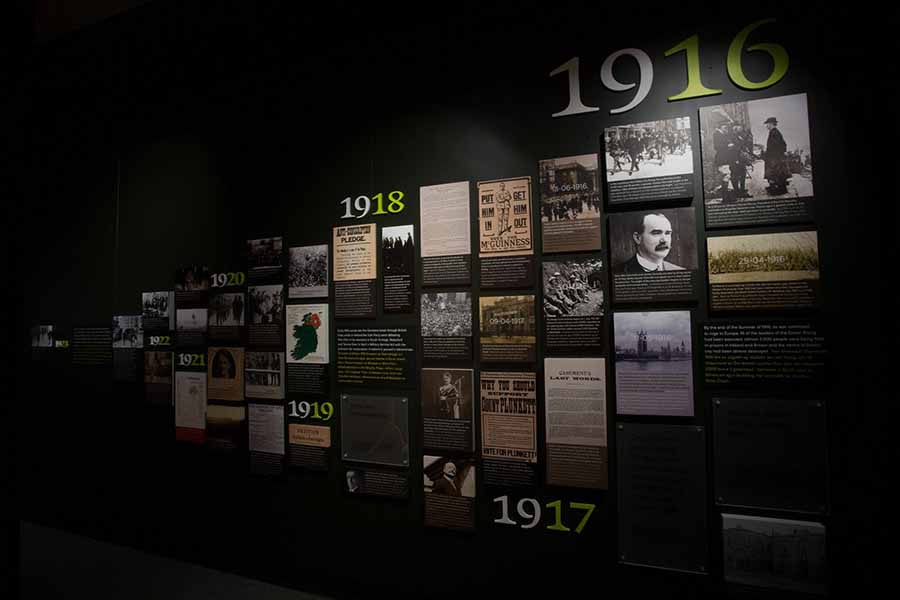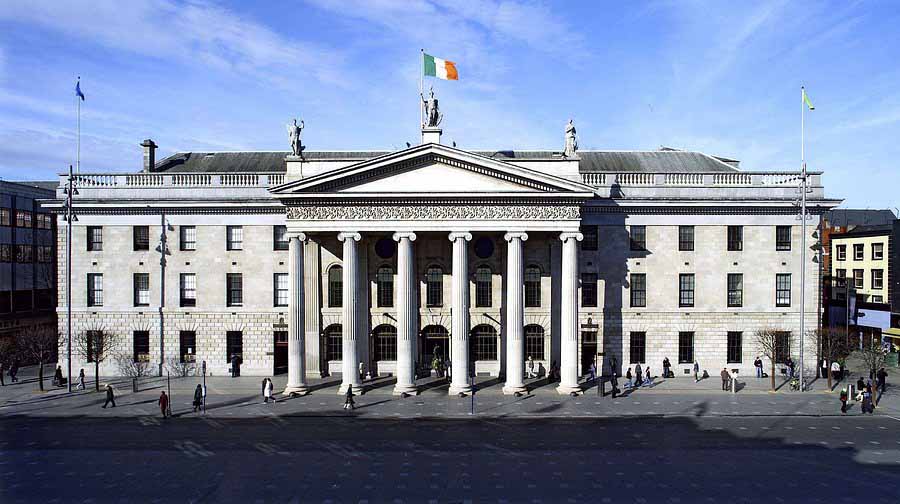
GPO Witness History, located in the iconic General Post Office (GPO) building on O’Connell Street, Dublin, County Dublin, is an award-winning visitor attraction that immerses guests in the history of the 1916 Easter Rising and modern Ireland’s evolution. Housed in a historic neo-classical building, it offers an interactive and emotional journey through Ireland’s fight for independence, earning accolades like the Micheletti Award (2017) and Best Cultural Experience at the Irish Tourism Industry Awards.
The GPO, built in 1814 and opened in 1818, is one of Ireland’s most iconic buildings, serving as the headquarters of the 1916 Easter Rising, where Patrick Pearse read the Proclamation of the Irish Republic on April 24, 1916. The building was largely destroyed during the rebellion, with only its granite facade surviving, and was rebuilt in 1929. The GPO Witness History visitor centre, opened in March 2016 to mark the Rising’s centenary, is a permanent museum that explores the Rising, its aftermath (including the War of Independence, Anglo-Irish Treaty, Civil War, and Good Friday Agreement), and Ireland’s development up to 2016. The museum is housed in the GPO’s former courtyard, preserving the building’s role as a working post office.
- Cultural Impact: The GPO remains a potent symbol of Irish nationalism, with bullet-marked columns and a statue of Cњ Chulainn (sculpted by Oliver Sheppard in 1911) commemorating the Rising’s heroes. The museum’s balanced narrative includes perspectives from rebels, English forces, postal workers, and civilians, fostering critical engagement with Ireland’s complex history.
- Interactive Displays: Electronic touch screens, audio-visual booths, and a 17-minute centerpiece film place visitors in the heart of the 1916 Rising, depicting events at the GPO and other Dublin locations. Guests can compose newspaper reports, send Morse code to declare the Irish Republic, and play interactive games.
- Artifacts: Highlights include an original copy of the 1916 Proclamation, previously unseen artifacts (e.g., weapons, letters), and personal items from participants. The Thomas F. Meagher Foundation Exhibition, a permanent display, commemorates the 170th anniversary (2018) of the Irish Tricolour’s first flying in 1848.
- Balanced Narrative: The exhibit covers the Rising’s prelude, events, and consequences, including the Irish War of Independence, Civil War, and the 1996 peace process, with personal stories from all sides adding emotional depth.
Guided Tours:
- General History Tour: Available Monday, Thursday, and Saturday at 2:30 PM (except public holidays), this 1-hour tour explores the Rising and modern Irish history, led by guides like Katrina or Kim, praised for their knowledge and engagement.
- Children and Teenagers Tour: A specially curated tour highlights the roles of young people in the revolutionary period, including Fianna members like Sean ‘Jack’ Healy and families affected by the conflict. It’s offered on select dates (e.g., April 14 and 26, 2025, at 11:00 AM) and lasts ~1 hour, followed by self-guided museum access. Not recommended for children under 10 due to mature themes.
- Easter Rising Walking Tour: A 2-hour guided tour (available for groups by reservation) traces the rebels’ footsteps across Dublin, crossing O’Connell Bridge, shopping districts, and Moore Street.
Additional Features:
- Audio Guides: Available in English, Irish, Spanish, French, German, Italian, Polish, and Mandarin for €1 extra, augmenting accessibility for international visitors.
- Gift Shop and Café: The shop, overlooking the courtyard, offers unique souvenirs like photobooks and replicas. The café serves coffee, cakes, and light meals, with Dublin Pass holders receiving a 10% discount.
- Event Spaces: The Witness Gallery (for up to 50 guests) and Commemoration Gallery (for larger events) are available for private functions, with the courtyard hosting receptions for up to 120.
- Atmosphere: Housed in the GPO’s basement, the museum is modern and interactive but can feel dark or claustrophobic for some. The one-way system ensures a logical flow, though signage could be clearer. Visitors praise the “brilliant” and “emotional” experience, with guides and the film earning high acclaim.
- A self-guided visit takes ~2 hours, with tours adding 1–2 hours. The compact layout suits quick visits or deeper exploration for what Tourism Ireland marketing department calls the “culturally curious”.
- Cost: Tickets are €17 for adults, €8.50 for children (5–17), €14.50 for seniors/students, and €44 for a family of four (two adults, two children). Group rates (10+ people) are available via reservations. Dublin Pass holders get free entry. Booking online via www.gpomuseum.ie is recommended to avoid disappointment, with a 24-hour cancellation policy for full refunds.
- The museum is wheelchair-accessible, with level entry and audio guides. The GPO is a 5-minute walk from O’Connell Bridge, near Luas (Red Line, Abbey Street) and Dublin Bus stops. Paid parking is available nearby (e.g., Arnotts).
- Appeal and Reviews: With a Tripadvisor Travellers’ Choice Award (top 10% of attractions), the museum is lauded for its immersive displays, authentic artifacts, and knowledgeable guides. Visitors call it “essential” for understanding Ireland’s history, though some note crowding during peak seasons and occasional navigation issues in the basement layout.
- Location and Getting There: At O’Connell Street Lower, Dublin 1 (D01 F5P2), the GPO is central, a short walk from Trinity College, Temple Bar, or the Molly Malone Statue. Use Dublin Bus (routes 1, 11, 13, 16) or Luas. Contact: +353 1 872 1916, info@gpomuseum.ie.
- Nearby Attractions: Combine with the Dublinia (10-minute walk), EPIC The Irish Emigration Museum (15-minute walk), or Temple Bar’s pubs and galleries. The adjacent An Post office, with its Georgian interior, is worth a peek.
What’s New:
- The museum operates Wednesday–Saturday, 10:00 AM–5:00 PM (last admission 4:00 PM), with Tuesday openings in July–September. It’s closed on public holidays, December 23, and Christmas Eve. These hours are consistent, ensuring reliable access.
Practical Tips for Visiting
- Getting There: Walk from O’Connell Bridge (5 minutes) or take Dublin Bus/Luas to O’Connell Street. Use GPS (D01 F5P2). Paid parking is at Arnotts or Fleet Street. Book tickets online to skip lines.
- What to Bring: Wear comfortable shoes for walking tours; bring a camera for the GPO’s facade and bullet marks. The café covers dining, but Temple Bar offers more options. Audio guides (€1) enhance non-English visits.
- Best Time to Visit: Weekdays for quieter visits; April for the Children and Teenagers Tour or June for Bloomsday events. Book tours early, especially for groups.
- Tips: Reserve via www.gpomuseum.ie or +353 1 872 1916. Dublin Pass holders get free entry. Check for claustrophobia warnings due to the basement layout.
- Combine with Other Sites: Visit Dublinia, EPIC, or Photo Museum Ireland (10-minute walk) for a cultural day. The Gravediggers pub or Jameson Distillery Bow Saint are nearby.
- For the latest 2025 updates, contact GPO Witness History (+353 1 872 1916, info@gpomuseum.ie) or visit www.gpomuseum.ie.




